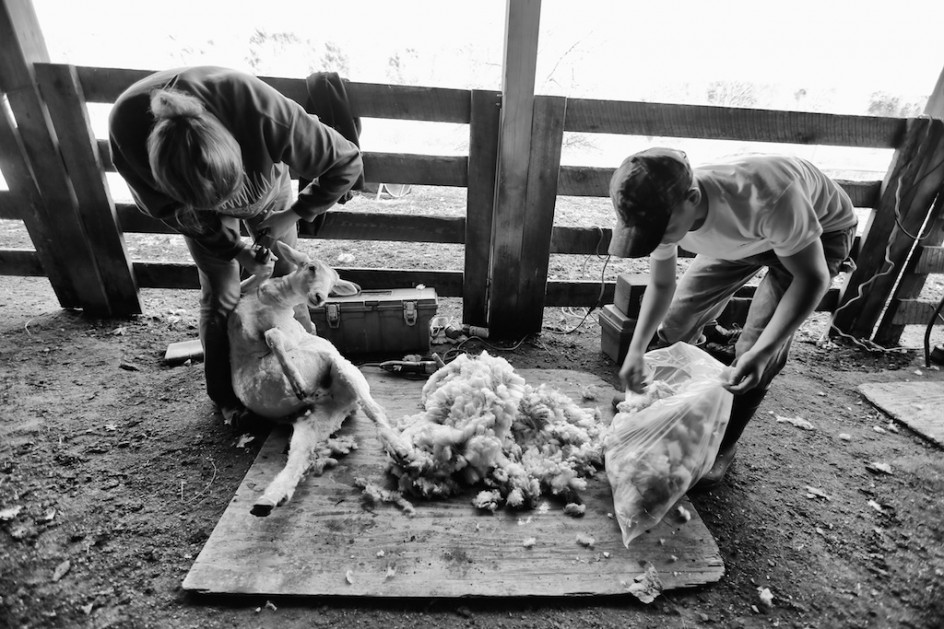
Jim McRae and Liz came from Vermont today to shear our eight sheep, our friend Tyler, who was here to help rake leaves, joined in and helped sort out the wool along with Maria, who will have it spun into yarn and sold. We shear our sheep twice a year, in the early Spring and mid-Autumn. Every time I post a photo of sheep being shorn at this time of year, many people express concern that we are harming the sheep, leaving them with little wool to fend off the approaching winter, often as harsh here as it is beautiful.
This annoyed me for awhile, I always wonder why people think we would put our sheep in danger or cause them to suffer extreme cold unprotected, but the carriage horses of New York have taught me to be less arrogant and impatient and to understand the importance of explaining what the real lives of animals are like. The very lives of animals can hang in the balance. It has become clear to me – Temple Grandin writes about this also – that many of the people in our world responsible for regulating the lives of animals and speaking for their rights have little or no contact with animals and seem to know nothing about them and what they truly need.
That is a deepening tragedy and an urgent concern for the animals left in our world. Safe and healthy animals like the New York Carriage Horses are now in danger while animals in the most dire need go unaided. Many institutions and individuals are giving up having animals rather than suffer the challenge, cost, invasive second-guessing and abuse that increasingly comes with owning them.
So every event like shearing is an opportunity for me to not only share the experience but also to help educate people about the real lives of real animals. They are not all dogs and cats, fragile pets to be sheltered and protected.
There are all kinds of sheep, but almost all of them are hardy, mountain or desert sheep that have been bred to handle extreme temperatures for thousands of years. A sheep needs about a quarter or half-inch of wool to be comfortable in even the harshest of winters, and sheep like ours – Border-Leicesters, one Karaluk from Asia (Kim) – will grow that and more in three or four weeks. By January, when the true winter arrives, they will have two or three times that.
Shearers shear sheep in New England in the middle of January and beyond, as long as there is shelter from the rain and ice and wind (we have that, of course). Shearers love sheep in the way that farriers love horses and donkeys, and no shearer would expose sheep to a brutal winter if they were not able to stay warm and comfortable. Even in some of the harshest weather, our sheep, given a choice, will prefer to be outside, huddled up with one another, letting their thick and lanolin-coated wool keep them warm.
It ought to go without saying – but doesn’t seem to – that Maria and I would not shear our sheep in late October if they could not keep themselves warm. We also offer them shelter year round, they mostly prefer it in the heat, but they have it all year. It is important to understand that animals like sheep – and draft horses – are not pets like dogs or cats. Horses, like donkeys and dogs, love to pull things and work, they love routine and tasks, it is what they are bred for. Because a sheep is shorn, it does not mean he or she is naked and exposed to the elements. Even after the shearing there is a coat of fur around the sheep, they are out grazing right now in cold temperatures with intermittent, rain, they are in no way uncomfortable and could go into shelter any time they wished.
People who keep animals are responsible for them, and if we are to have animals in our world, they need to be respected and supported, not over-policed and harassed. We could easily get rid of our sheep and save money on hay and time on chores, but we love having them, and they lead good and comfortable lives.
One day, perhaps I will post photos of sheep being shorn in October without people writing me to say how cruel it must be. Sitting at their computers in cities or the suburbs, they don’t seem to know that sheep have been shorn in October since the dawn of civilization, and it is both healthy and comfortable for them to be clean and carry less weight. But curiously, they think they know.
Perhaps one day, an animal rights group will give a mayor or state legislators enough money to ban the shearing of sheep after Labor Day or before June. I would sell mine, of course, like so many others would, they would almost surely go to market, as has happened to so many other animals saved by people who know nothing about them. There will be no jackets on these sheep, no matter what the weather and we look forward to Jim and Liz coming back in the Spring. I appreciate the chance to present the truth about the real lives of animals, I believe the future of animals depends on it.
